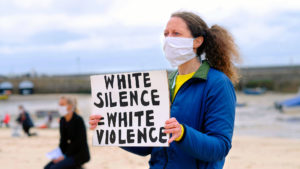Some years ago, I taught a course in public writing at the Claremont colleges, the consortium of elite liberal arts institutions in Southern California. My students were juniors or seniors, mostly humanities or social science majors, almost all smart, a couple genuinely brilliant. All, needless to say, were expensively educated and impressively credentialed. I assumed that they’d arrive with a fairly good idea of how to make an argument with an academic context and that I would be teaching them how to apply those skills to a very different set of rhetorical occasions.
What I soon discovered was that none of them had much idea how to make an argument in any context. Nor were they particularly skilled at analysing the arguments of others. They didn’t know how to read; they didn’t know how to write; and they didn’t know how to think.
What do I mean? The syllabus consisted, for the most part, of short exemplary texts: a column by David Brooks, a blog post by Ta-Nehisi Coates, and so forth. But whenever I assigned them anything a little more complex or sophisticated, it flew over their heads. These were students who were used to the idea that reading meant skipping and skimming.
Their writing was not much better. Most were competent at a basic level, but none had had any real guidance or instruction. One week, we did an exercise designed to help them make their prose more vivid and energetic. I had them read a short piece of writing pedagogy, then handed out a sheet on which I’d reproduced a single sentence from each of their most recent pieces that needed that kind of attention.
We set to work on the first, dissecting, pruning, and rewriting. After about ten minutes, we had it in decent shape; it wasn’t graceful yet, but at least it was concise. And then I said, “Okay, it’s taken thirteen of the finest minds in Claremont ten minutes to rewrite that sentence. This is what you need to do with every sentence you write.” They looked at me with horror and amazement. It wasn’t just the scale of the task that was rising before them. It was also the fact that no one had bothered to tell them that before.
It was then I finally understood something that my students had told me the first day of class. I had asked them to introduce themselves and talk about their strengths and weaknesses as writers. Many had said some version of “I’m good at writing naturally” or “I’m good at writing conversationally,” “but I’m not good at revising” or “I’m not good at editing”. What they had been telling me, I realised that day in the middle of the semester, was that they thought of writing as something that just happens, that they had never been asked to pay attention to their sentences as conscious constructions.
As for their thinking, they had the same relationship to their arguments as they had to their prose. They just made them; they didn’t and really couldn’t think about them in a metacognitive way. They couldn’t recognise contradictions, anticipate objections, entertain alternative interpretations, make essential distinctions, or delineate the limits of their propositions. Remember, this wasn’t freshman composition. This was an advanced writing seminar at some of the most prestigious colleges in the country.
These problems weren’t confined to Claremont. Later that same year, in a piece about the differences between the way his students read Shakespeare and the way that students used to, Stephen Greenblatt wrote this:
“Even the highly gifted students in my Shakespeare classes at Harvard are less likely to be touched by the subtle magic of his words than I was so many years ago or than my students were in the 1980s in Berkeley. What has happened? It is not that my students now lack verbal facility… In fact, they write with ease, particularly if the format is casual and resembles the texting and blogging that they do so constantly. The problem is that their engagement with language, their own or Shakespeare’s, often seems surprisingly shallow or tepid.”
A little later Greenblatt writes, “When I ask them to write a 10-page paper analyzing a particular web of metaphors, exploring a complex theme or amassing evidence to support an argument, the results are often wooden.”
Note how similar his observations are to mine. Note especially that sentence in the middle: “In fact, they write with ease, particularly if the format is casual.” As my students were at Claremont, Greenblatt’s at Harvard are able to write “naturally,” to write “conversationally”, but are at a loss when it comes to writing formally, or to reading complex texts in ways that are more than “shallow or tepid”, or to making arguments that are better than “wooden” (which sounds like a euphemism for “bad”). That they “write with ease” despite having a “shallow or tepid” engagement with their own language is part of the problem.
Greenblatt offers the familiar explanations for these generational differences: the rise of the internet, the emergence of social media, and so forth. But he neglects to address the fact that Harvard undergraduates are supposed to be among the exceptions. The students in his Shakespeare class undoubtedly boast a median verbal SAT score in the upper 700s (out of 800). The large majority probably received a perfect score of 5 on the AP (Advanced Placement) English exam. If any group of college students should be capable of deciphering complex texts, writing incisive expository prose, and constructing compelling analytic arguments, it is they. But apparently they’re not.
To understand how this predicament came to pass, one needs to understand how students manage to get into places like Harvard or the Claremont colleges in the first place. It is not by learning how to read, write, or think. It is by jumping through the endless series of hoops that elite college admissions offices have developed over the decades to winnow down their skyscraper stacks of application folders.
To win a place at such a school, students most receive top grades in a broad range of AP courses, show evidence of participation in a dozen or more extracurricular activities—sports, arts, student government, et al.—demonstrate “leadership”, engage in “service”, and gather experiences, often through purpose-built programs, to write about on their personal essays, statements designed to convince the admissions officer of the existence of an actual human being beneath the credentials. To do all this, they will work without cease for years on end, sleeping little and foregoing the freedoms of adolescence.
This is not a system that’s designed to foster intellectual engagement. Students learn to skip and skim, not just their assigned readings, but everything. Everything is done at maximum speed and with the least possible effort. Curiosity and passion must be actively suppressed. Students become experts, not so much in subjects as in working the system. There is simply no time to do anything else.
This is not to say that things are better below the level of the elite. For many years, public education in the United States has been dominated by high-stakes assessment regimes. Schools, accordingly, “teach to the test”, foregoing the development of holistic understanding in favour of the grinding repetition of isolated skills (a practice known as “drill and kill”). And since the tests cover math and reading only, many subjects have been stripped from the curriculum, along with any opportunity for students to follow the wayward path of their own interests. The system might almost have been devised for the express purpose of destroying the love of learning.
If that’s the kind of education students have received by the time they get to college, do things get better once they arrive? Not usually. Old habits die hard. Elite students, already competing for the next prize, continue to conduct their lives at the same frenetic pace. At the large mass of institutions below the level of the elite, the problem is less apt to be misdirected zeal than sheer indifference. Courses are a bother; campus culture runs to sports and beer.
Nor will students get much help from their professors. As I’ve travelled to colleges and universities around the country over the last 14 years, I’ve been stunned by the sheer laziness of so much undergraduate instruction. Professors on the tenure track have no incentive to care about their teaching, and a great deal of incentive not to. The adjuncts and other contingent instructors who make up the vast majority of the American faculty — underpaid, overworked, and sometimes teaching well outside their field — simply don’t have time to do a proper job.
The whole creaking machine is lubricated by the magic grease of grade inflation. As of the early Sixties, 15% of grades at American colleges and universities fell within the A range. By 2013, the proportion had reached 45%. To paraphrase the joke from the old Soviet Union, students pretend to work, and professors pretend to grade them.
It is within the context of these forms of collegiate stupidity that we can understand the one that is now the most salient: wokeism. Wokeism can be thought of as the opportunistic infection of a host with an already weakened intellectual immune system. Students haven’t learned to think, so they lack the means to spot its inconsistencies, its hypocrisies, its absurdities. They haven’t learned to read, so they uncritically absorb its empty language. They know little of history, so they accept whatever tendentious version wokeism hands them.
Wokeism also satisfies important psychic needs, of the kind that education ought to address but does not. It provides students with an interpretive framework with which to understand the world. For earlier generations of young adults, that function would have been performed by Marxism or Freudianism or feminism or liberal progressivism or American patriotism. All have long since been discredited except for feminism, which had itself been in abeyance and has now been absorbed by, and subordinated to, the new intersectional identitarianism.
Indeed, after decades of postmodernism, with its assault on the very idea of grand interpretive narratives, wokeism represents a return of the repressed — the repressed in this case being the ineluctable human hunger for meaning. For wokeism, like those earlier belief systems, offers a framework that is not only cognitive and historical, but also moral and existential. It tells you not only where you come in, but also who you are and how you are to orient yourself toward others and the world. In other words, it offers purpose and direction.
I am not suggesting colleges should play that role. They should play a better one: instead of telling students what to think and how to live, equipping them to work those questions through for themselves. But that’s a mission institutions long ago abandoned. It’s too hard; it requires professors to see themselves as mentors, with all the commitment of time and energy and feeling that entails; and it implies a level of self-confidence, a willingness to confront students with the idea that their education ought to be about something more than becoming as wealthy as possible, that colleges and universities no longer have.
In the absence left by that delinquency has flourished the careerism that has come to dominate the American collegiate experience. For many years now, students have told me how empty, how meaningless, their education feels. Which means that wokeism fills a void that’s ethical as well as intellectual. Under its ascendancy, campuses are once again alive with moral zeal.
In telling students what to think, wokeism also provides them with something to say. The value of this should not be underestimated, particularly in the age of social media. Having opinions — easily, instantly, on everything — is essential to the contemporary presentation of the self. The process of forming them is aided immensely if you already know where you’re supposed to stand on every subject, including ones you haven’t heard of yet.
Of course, college students have always been champion spouters. But there are some crucial differences today. The most important fact about the alternative intellectual frameworks I enumerated earlier — Marxism, Freudianism, and so forth — is that they existed not in series but simultaneously. They were ideologies, but they were competing ideologies. Indeed, they each represented a menagerie of mutually competing sub-ideologies: Leninism, Trotskyism, Maoism, Marxist humanism; the schools of Jung and Reich as well as Freud; the rival strains of second-wave feminism.
Which meant that students couldn’t just believe: they had to debate, had to read the sources, had to know what they were talking about. Debate and contention were pretty much what it meant to be a college student, at least at the schools and in the circles that took themselves seriously. So while wokeism represents a reemergence, after many years of intellectual prostration (on campus as in public life), of ideas and ideology, it does so on very different terms. With wokeism, there is no debate. There are no competing ideologies or rival schools. There isn’t even much of any reading, from what I can tell. There is only assent.
Another thing is different now, as well. Professors are different. No longer do they see their role as challenging students’ unexamined convictions — of scraping the stupid off their brains, as the documentarian Rob Montz has put it. The old salutary adversarialism has been replaced by an insidious alignment of views. Students and professors now are social justice warriors together, marching in lockstep, wreathed in clouds of self-congratulation, for the one true cause.
But this is really no surprise. Wokeism, as a bundle of intellectual tendencies, began in the academy. Decades on — academics being great conformists — dissent has largely been bred out. Meanwhile, leftist professors (that is, most of them), ensconced in bureaucratic institutions and the upper middle-class, are desperate to hold onto their self-image as subversives, speaking truth to power (in their monographs), doing battle with the system (that pays their salaries).
Besides, as parents themselves, in most cases — parents in the modern mold — they are allergic to authority, uncomfortable with negativity, and eager to be seen as friends. The degree of student ass-kissing that I’ve observed among professors now is something to behold. The situation, in many respects, is reminiscent of the Sixties: an era of social upheaval, a feeling by the grown-ups that they’re being left behind, a compensatory worship of the young (“these kids are going to save the world”), all tending to stifle the impulse to question or challenge. If you can’t teach ‘em, join ‘em.
Finally, the schools are different, too. Having searched for decades for a rationale for their existence that is more respectable than training workers for the labour force, they’ve embraced the cause of wokeism as the new institutional mission. We have entered the era of the social-justice college. Schools now bill themselves as places to learn, not to understand the roots of contemporary society or contribute to the stock of human knowledge, but to “change the world.”
And everybody understands that the world means only in one direction. I was speaking with an old friend who works at Columbia. She asked me why we shouldn’t teach our students how to “instrumentalise” the things they learn from us. I said, fine, as long as you’re okay if a student instrumentalises what they learn from you to try to overturn Roe v. Wade. She looked at me in horror; the possibility had clearly never crossed her mind.
I spent some time a couple of years ago at the University of San Diego, a private institution. The campus was adorned with banners bearing slogans such as “Be — The — Change” and “Shape — a better — World”. One young man I met there, one of the few students who seemed intellectually alive, likened them to prayer flags. The faculty member who brought me to campus remarked that schools were in danger of turning themselves into madrassas. The New School university in New York, founded as the New School for Social Research in 1919 at the height of the Red Scare, as a bastion of free intellectual inquiry, now employs a Senior Vice President for Social Justice. From social research to social justice: that pretty much sums up the trajectory.
Is there any real learning still happening at American colleges and universities? Of course there is: in the interstices, the institutional cracks, where it can evade the surveillance of the diversity deanlets and the persecutions of the PC police. It survives behind the doors of the classrooms and in the quiet of the offices of the dwindling minority of true teachers who remember what it looks like and are committed, come what may, to keeping it alive. It persists inside the dorm rooms and the brains of the few recalcitrant students — the real campus subversives — who insist on being individuals, on thinking things through for themselves. May it live to see the end of this new dark age.
A longer version of this essay appeared in the Dutch-English journal Nexus. Permission to reprint is gratefully acknowledged by the author.
Disclaimer
Some of the posts we share are controversial and we do not necessarily agree with them in the whole extend. Sometimes we agree with the content or part of it but we do not agree with the narration or language. Nevertheless we find them somehow interesting, valuable and/or informative or we share them, because we strongly believe in freedom of speech, free press and journalism. We strongly encourage you to have a critical approach to all the content, do your own research and analysis to build your own opinion.
We would be glad to have your feedback.
Source: UnHerd Read the original article here: https://unherd.com







